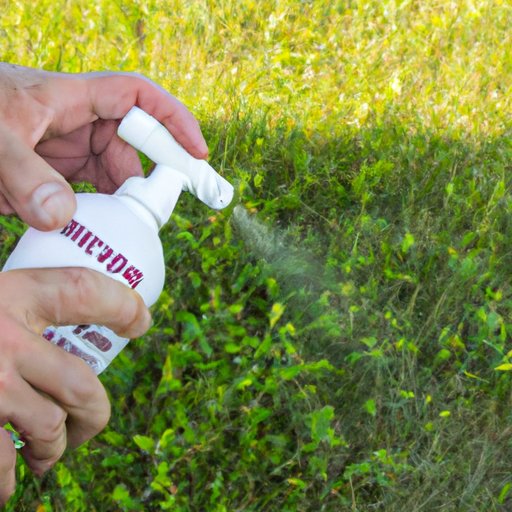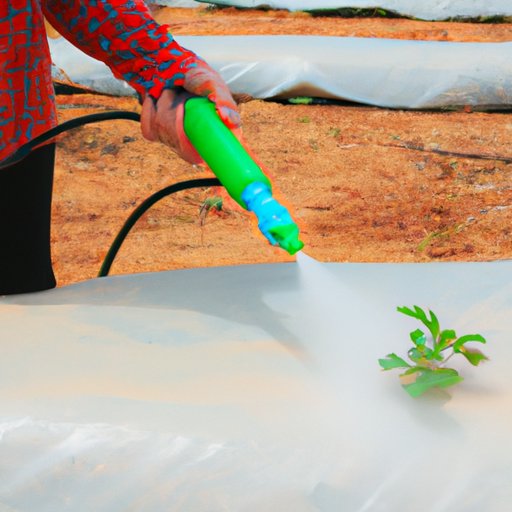Introduction
Preen is a brand of weed control products that have been around since 1981. It’s used to prevent weeds from taking root in lawns, gardens, and other areas where unwanted plants can be a nuisance. Its active ingredient is trifluralin, which is a pre-emergent herbicide. This means that it works by stopping weed seeds from germinating, rather than killing existing weeds.
Weed control can be a difficult task, especially in areas where there are a lot of different types of weeds. Different weeds require different treatments, and some weeds can be resistant to certain herbicides. Preen is a great option for those who want to keep their lawns and gardens weed-free without having to resort to more extreme measures.

Exploring the Science Behind How Preen Works
The chemical composition of Preen is what makes it so effective at controlling weeds. Trifluralin is an organic compound that works by inhibiting cell division in young weeds. When a weed seed germinates, it produces a small root that anchors the plant in the soil. Trifluralin prevents this root from forming, so the weed cannot take hold and grow.
Preen also contains other ingredients such as fertilizers and surfactants. Fertilizers help nourish the soil and provide nutrients for healthy plant growth. Surfactants are compounds that reduce the surface tension of water, allowing it to spread more easily over the soil and reach the roots of the weeds.
An In-Depth Look at How Preen Keeps Weeds Under Control
Preen comes in a variety of forms, including granular, liquid, organic, and synthetic. Granular preen is a dry powder that is spread on the soil and then watered in. Liquid preen is applied with a sprayer and requires less effort to apply. Organic preen is made from natural ingredients such as corn gluten meal and is safe for the environment. Synthetic preen is a chemical-based product that is usually more potent than organic preen but can be harmful if not used properly.
Each type of preen has its own set of pros and cons. Granular preen is easier to apply and generally lasts longer, but it can be harder to spread evenly over the soil. Liquid preen is faster to apply but may need to be reapplied more often. Organic preen is safer for the environment but may not be as effective as synthetic preen. Synthetic preen is more powerful but can be dangerous if not used correctly.
When applying preen, it’s important to follow the instructions carefully and use the right amount for the area you’re treating. Applying too much preen can damage plants and cause other issues, while applying too little won’t be effective at controlling weeds. Additionally, preen should be applied before weeds have a chance to germinate, as it will not work on existing weeds.
Comparing Different Types of Preen and Their Benefits
Granular and liquid preen both have their advantages and disadvantages. Granular preen is easier to spread over large areas and can last up to two months if watered in correctly. Liquid preen is faster to apply and can be used in hard-to-reach areas, but it doesn’t last as long as granular preen.
Organic preen is made from natural ingredients, so it’s safer for the environment and won’t harm beneficial insects or other wildlife. However, it may not be as effective as synthetic preen. Synthetic preen is more powerful but can be dangerous if not used correctly. Specialized preen products, such as those designed for vegetable gardens, can be helpful for targeting specific weeds.
A Comprehensive Guide to Using Preen for Maximum Effectiveness
Before you apply preen, it’s important to prepare your garden. Remove any existing weeds and rake the soil to loosen it up. This will help the preen spread more evenly and be more effective at preventing weeds from growing.
When applying preen, make sure you use enough for the size of the area you’re treating. If you’re using granular preen, use a rotary spreader to ensure even coverage. For liquid preen, use a sprayer to apply it evenly over the soil. Be sure to follow the instructions on the package when applying preen.
Once you’ve applied preen, it’s important to reapply it every few months to ensure long-term weed control. If you live in an area with heavy rainfall, you may need to reapply more often. It’s also important to monitor your garden for any signs of weed growth and take action if necessary.

Understanding the Benefits of Preen for Vegetable Gardens
Preen is a great option for vegetable gardens because it can help keep weeds under control without harming the vegetables. It helps prevent weed seeds from germinating, which can make it easier to keep the garden free of weeds. It can also help nourish the soil and promote healthy plant growth.
Preen can also be used in conjunction with other weed control methods, such as mulching or hand-weeding. This can help keep the weeds under control without having to use harsh chemicals. Additionally, preen can help protect vegetables from pests, such as slugs and snails, which can be a problem in vegetable gardens.

Tips for Applying Preen for Optimal Weed Control
Timing is key when applying preen. Applying it too early or too late won’t be effective at controlling weeds. Generally, it’s best to apply preen in late winter or early spring, before weeds have a chance to germinate.
It’s also important to make sure you use enough preen for the size of the area you’re treating. Too little won’t be effective at controlling weeds, while too much can cause damage to plants. Reading and following the instructions on the package is the best way to ensure you’re using the right amount.
Finally, post-application maintenance is important for keeping weeds under control. Monitor your garden for any signs of weed growth and take action if necessary. Reapplying preen every few months can help maintain long-term weed control.
Conclusion
Preen is an effective and easy-to-use weed control product that can help keep your lawn and garden weed-free. It comes in a variety of forms, including granular, liquid, organic, and synthetic, and each type has its own set of benefits. When applied correctly and regularly, preen can help keep weeds under control without damaging plants or the environment.
For optimal results, it’s important to prepare the soil before applying preen, use the right amount, and reapply it every few months. Following these steps can help ensure that your lawn and garden stay weed-free all season long.
(Note: Is this article not meeting your expectations? Do you have knowledge or insights to share? Unlock new opportunities and expand your reach by joining our authors team. Click Registration to join us and share your expertise with our readers.)
